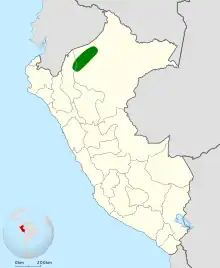White-masked antbird
The white-masked antbird (Pithys castaneus) is a bird species in the family Thamnophilidae. It is endemic to Peru.
| White-masked antbird | |
|---|---|
| Scientific classification | |
| Domain: | Eukaryota |
| Kingdom: | Animalia |
| Phylum: | Chordata |
| Clade: | Dinosauria |
| Class: | Aves |
| Order: | Passeriformes |
| Family: | Thamnophilidae |
| Genus: | Pithys |
| Species: | P. castaneus |
| Binomial name | |
| Pithys castaneus Berlioz, 1938 | |
 | |
| Synonyms | |
|
Pithys castanea | |
Its natural habitat is subtropical or tropical moist lowland forests. This little-known bird was formerly considered a data deficient species by the IUCN.[2] But new research has found it somewhat rare and declining. Consequently, it is classified as Near Threatened in 2008.[3]
References
- BirdLife International (2018). "Pithys castaneus". IUCN Red List of Threatened Species. 2018: e.T22701859A132070800. doi:10.2305/IUCN.UK.2018-2.RLTS.T22701859A132070800.en. Retrieved 11 November 2021.
- BLI (2004)
- BLI (2008)
- BirdLife International (BLI) (2008): [2008 IUCN Redlist status changes]. Retrieved 2008-MAY-23.
This article is issued from Wikipedia. The text is licensed under Creative Commons - Attribution - Sharealike. Additional terms may apply for the media files.
